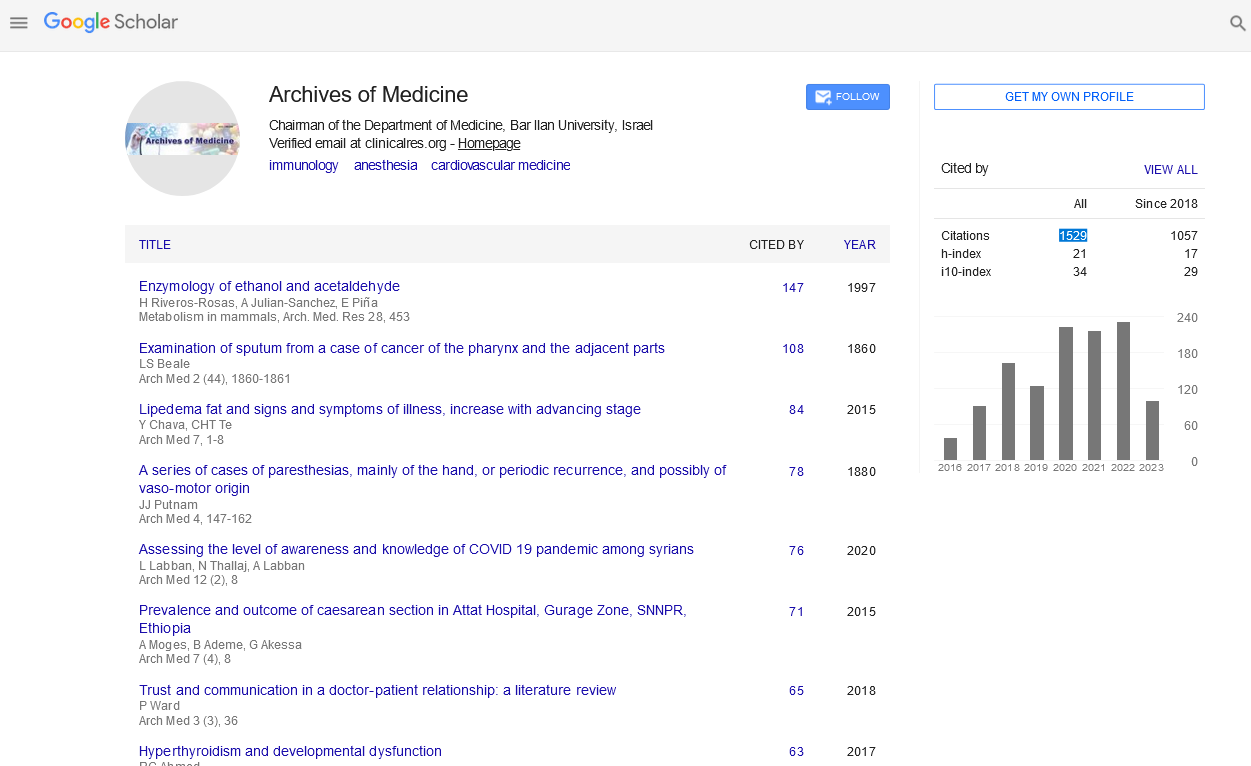Opinion - (2024) Volume 16, Issue 5
Exploring neurology: Breakthroughs in understanding the brain and nervous system
Christopher Hall1*,
Vishal Singh1,
Jonah N Friedenberg2 and
Daniel Foster2
1Department of Neurology, Johns Hopkins University School of Medicine, Baltimore, MD 21205, USA
2Center for Brain Research, Massachusetts General Hospital, 55 Fruit Street, Boston, MA 02114, USA
*Correspondence:
Christopher Hall, Department of Neurology, Johns Hopkins University School of Medicine, Baltimore, MD 21205,
USA,
Email:
Received: 20-Aug-2024, Manuscript No. ipaom-24-15401;
Editor assigned: 22-Aug-2024, Pre QC No. P-15401;
Reviewed: 03-Sep-2024, QC No. Q-15401;
Revised: 09-Sep-2024, Manuscript No. R-15401;
Published:
16-Sep-2024
Introduction
Neurology is a dynamic field that delves into the intricacies of the brain and nervous system, seeking to unravel the complexities of neurological disorders and their impacts on human health. As one of the most vital and enigmatic systems in the body, the brain governs not only our physical functions but also our thoughts, emotions, and behaviors. Recent breakthroughs in neuroscience have significantly advanced our understanding of various neurological conditions, ranging from neurodegenerative diseases like Alzheimer’s and Parkinson’s to psychiatric disorders such as depression and schizophrenia. These advancements are fueled by innovative research techniques, including advanced imaging modalities, genetic studies, and novel therapeutic approaches. This article explores the latest breakthroughs in neurology, highlighting their implications for diagnosing, treating, and ultimately improving the quality of life for individuals affected by neurological disorders.
Neurology is a dynamic and ever-evolving field dedicated to understanding the intricate workings of the brain and nervous system. This specialty explores how these complex systems govern not only our bodily functions but also our thoughts, emotions, and behaviors. The brain, as the control center of the body, plays a crucial role in nearly every aspect of human life, from basic motor skills to higher cognitive functions like decision-making and memory. Given the staggering number of individuals affected by neurological disorders—ranging from neurodegenerative diseases like Alzheimer’s and Parkinson’s to mental health conditions such as depression and anxiety—the importance of advancing our understanding of these disorders cannot be overstated [1].
Description
Recent developments in neurology have revolutionized our understanding of the brain and nervous system, offering new insights into their structure, function, and pathology. Advanced neuroimaging techniques, such as functional MRI (fMRI) and Positron Emission Tomography (PET), allow researchers to visualize brain activity in real time, providing valuable information about how different areas of the brain communicate and function. These imaging technologies have not only enhanced our knowledge of normal brain functioning but have also facilitated the identification of abnormalities associated with various neurological disorders. Genetic research has also played a pivotal role in understanding the hereditary aspects of neurological conditions. Discoveries related to specific gene mutations linked to diseases like Huntington’s disease and certain forms of epilepsy have paved the way for early diagnosis and potential gene-targeted therapies. As researchers continue to explore the genetic underpinnings of these conditions, the promise of personalized medicine in neurology becomes more tangible, allowing for tailored treatment plans that address the unique genetic profiles of patients [2].
In addition to genetic advancements, breakthroughs in neurobiology have shed light on the underlying mechanisms of neurodegeneration and repair. For instance, studies on neuroinflammation and the role of glial cells in supporting neuronal health have opened new avenues for therapeutic interventions. Researchers are now exploring how to harness the brain's natural repair mechanisms to promote recovery after injury or disease. Moreover, the integration of technology in neurology has resulted in innovative therapeutic approaches. Neuromodulation techniques, such as Transcranial Magnetic Stimulation (TMS) and Deep Brain Stimulation (DBS), are being used to treat conditions like depression and movement disorders, offering hope for patients who do not respond to traditional treatments. Additionally, advancements in digital health technologies, including mobile health applications and wearable devices, are enabling continuous monitoring of neurological symptoms, providing valuable data for both patients and healthcare providers [3].
The collaborative nature of modern neuroscience research has further accelerated progress in the field. Interdisciplinary teams of neurologists, psychologists, geneticists, and engineers are working together to tackle complex neurological issues, fostering an environment of innovation and discovery. This collaborative approach is essential for translating scientific findings into practical applications that improve patient care and outcomes. Recent breakthroughs in neuroscience are significantly transforming our understanding of both normal brain function and the pathological processes that underlie neurological diseases. Innovative research techniques, including advanced neuroimaging modalities, genetic studies, and computational modeling, are providing unprecedented insights into the brain's structure and functionality. These advancements are not only enhancing our grasp of various neurological conditions but are also paving the way for novel therapeutic strategies aimed at improving patient outcomes.
The field of neurology has witnessed a paradigm shift as researchers increasingly recognize the multifaceted nature of neurological disorders. Conditions that were once thought to be purely degenerative or psychiatric are now understood to involve complex interactions between genetics, environmental factors, and lifestyle choices. This holistic perspective underscores the importance of interdisciplinary collaboration among neurologists, psychologists, geneticists, and other healthcare professionals, who work together to develop comprehensive treatment plans tailored to individual patient needs [4]. As we delve deeper into the mysteries of the brain, the integration of cutting-edge technologies—such as artificial intelligence and machine learning—promises to further accelerate advancements in diagnosis and treatment. These technologies are enabling researchers to analyze vast datasets, identify patterns, and develop predictive models that can inform clinical practice.
In this article, we will explore the latest breakthroughs in neurology, emphasizing their implications for diagnosing, treating, and ultimately enhancing the quality of life for individuals affected by neurological disorders. By shedding light on these significant developments, we aim to highlight the critical importance of ongoing research and innovation in the field of neurology, as well as the potential they hold for improving healthcare outcomes for patients around the world [5].
Conclusion
The field of neurology is undergoing a transformative period marked by significant breakthroughs in our understanding of the brain and nervous system. From advanced imaging techniques that illuminate brain function to genetic discoveries that offer insights into hereditary neurological conditions, these advancements are reshaping the landscape of diagnosis and treatment. As researchers continue to explore the complexities of neurological disorders, the promise of personalized medicine and innovative therapeutic approaches holds great potential for improving patient outcomes.
Looking ahead, the integration of technology and interdisciplinary collaboration will be crucial for further advancements in neurology. By harnessing the power of innovation, we can continue to unlock the mysteries of the brain, ultimately enhancing our ability to diagnose, treat, and support individuals living with neurological conditions. As we deepen our understanding of the nervous system, we move closer to a future where effective, tailored interventions lead to better quality of life for patients and their families. The ongoing exploration of neurology not only enriches our scientific knowledge but also underscores the importance of compassionate care in addressing the challenges posed by neurological disorders.
Acknowledgment
None.
Conflict of Interest
None.
References
- Mologousis MA, Tsai SY, Tissera KA, et al. Updates in the management of congenital melanocytic nevi. Children. 2024 2;11(1):62.
Google Scholar, Crossref, Indexed at
- Bett BJ. Large or multiple congenital melanocytic nevi: occurrence of cutaneous melanoma in 1008 persons. J Am Acad Dermatol. 2005 1;52(5):793-7.
Google Scholar, Crossref, Indexed at
- DeDavid M, Orlow SJ, Provost N, et al. A study of large congenital melanocytic nevi and associated malignant melanomas: review of cases in the New York University Registry and the world literature. J Am Acad Dermatol. 1997 1;36(3):409-16.
Google Scholar, Crossref, Indexed at
- Krengel S, Scope A, Dusza SW, et al. New recommendations for the categorization of cutaneous features of congenital melanocytic nevi. J Am Acad Dermatol. 2013 1;68(3):441-51.
Google Scholar, Crossref, Indexed at
- Marghoob AA, Dusza S, Oliveria S, et al. Number of satellite nevi as a correlate for neurocutaneous melanocytosis in patients with large congenital melanocytic nevi. Arch Dermatol. 2004 1;140(2):171-5.
Google Scholar, Crossref, Indexed at






